General Zorawar Singh Fort, or simply Zorawar Fort Leh as it is popularly known, is situated on the Skara Road, Leh, in Ladakh. It is a prominent attraction of Ladakh built by Zorawar Singh in 1836 during Maharaja Gulab Singh’s era.
General Zorawar Singh constructed this fort as a military post for the Dogra soldiers and the snow warriors of Ladakh. Today this fort is an excellent tourist spot, which attracts thousands of tourists from all over the country, mainly from Punjab.
Architecture:
The fort gate is constructed out of local materials, and so are the buildings of the fort.
The fort comprises several small buildings constructed of sun-dried blocks made up of stones, mud, and clay dating back to the nineteenth century.
The attractions inside the Zorawar fort Leh
The beautiful paintings inlaid on the walls and the attires are a sight to behold. One can get to know about the heritage of the fort through these artifacts. The major attractions worth visiting and must-see while visiting this fort are the War room, History room, and the Artefacts room. All these have their interests and are worth seeing.


Visiting the Zorawar fort Leh is exciting and highly enjoyable if you have planned it well. If you are reading this article to know about the Zorawar fort Leh, then you are at the right place. We have covered almost everything on Zorawar fort in this article. So, this article will provide you with all the required information about Zorawar fort Leh.
My tour experience at the Zorawar Fort Leh
We booked a taxi from our hotel and decided to visit the Zorawar Fort. Our hotel was in the Main Market, so we reached there in 5 minutes, at around 11 am in the morning.


A small ticket room was built outside the fort where the entry fee per person was mentioned 20 rupees. We took the tickets from the ticket counter and entered the fort. The path was lined up with beautiful lanterns on their stands. We noticed that most visitors inside the fort were Sikhs.
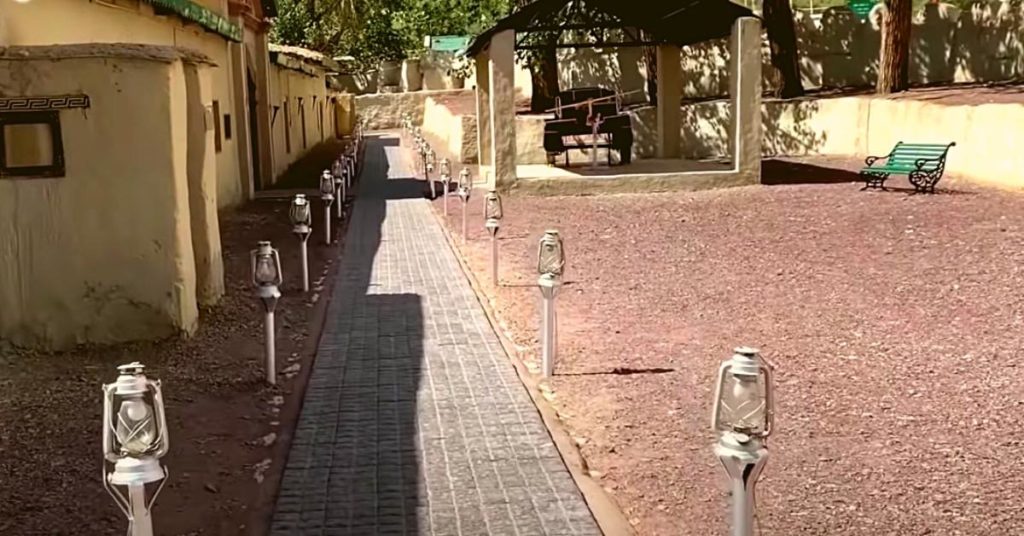

As we walked along the pathway, we noticed a small room named ‘Topekhana’. The doors were kept locked by the management authority, and we were not allowed to move inside those rooms.
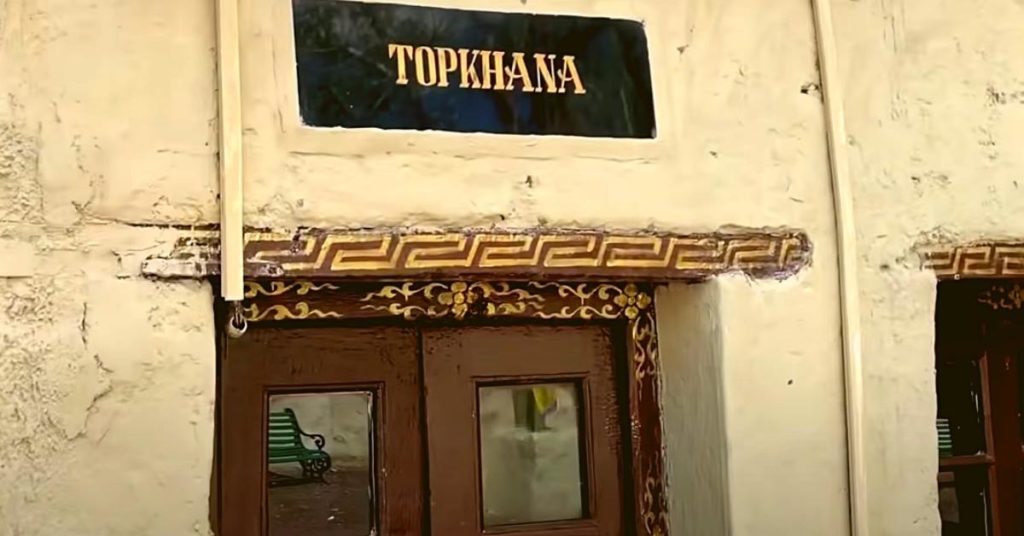

The entire fort was built with white clay, and the wooden windows with beautiful golden borders gave a unique look overall. There was a sentry post near the entrance where a guard would be kept on watch for approaching police, enemy, or danger.
Zorawar Museum


After that, we entered the Zorawar Museum, where we saw a splendid bust of General Zorawar Singh. The valorous sculpture of Zorawar Singh infused a wave of extreme patriotism inside us. The legend behind the fort was enough to inculcate a sense of patriotism in such a magnificent monument. On the wall, there was a detailed description of Maharaja Gulab Singh (The Founder of Jammu and Kashmir), General Zorawar Singh (Napolean of India and Conquerer of Ladakh), and Mehta Basti Ram (Military Commander).
There were two halls in the museum named Artefacts Room and History Room.
Artifacts Room


We entered the Artifacts Room first, where we saw some cookware, utensils, and different types of belts and shields used by the warriors. The shield was locally known as Phali. It was made up of leather and metal that were obtained from Turtuk and Basgo. There were chest armors made of hard steel and brass used by the Dogra, Ladakhi, and Chinese troops during wars.
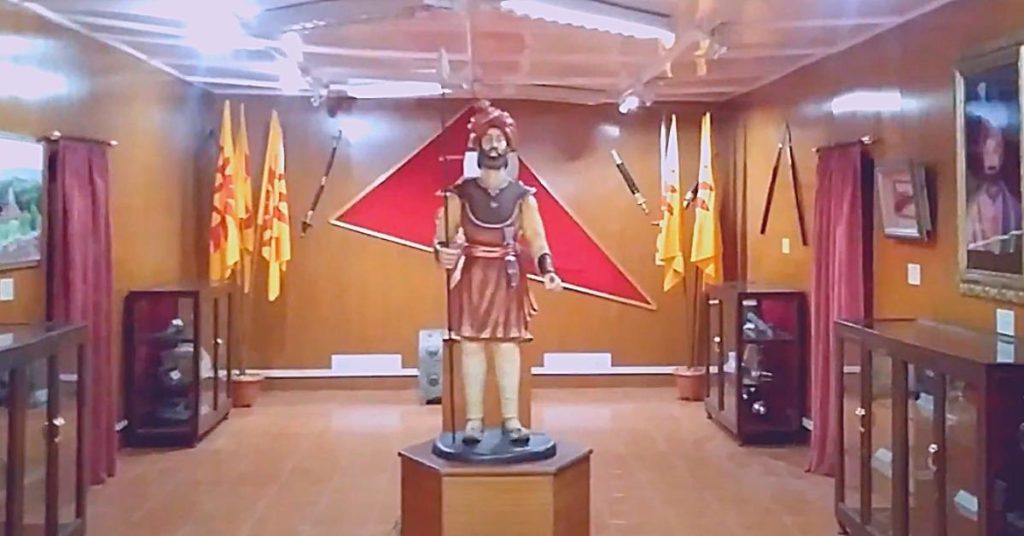

On the other wall, photographs of beautiful and famous sites and tourist attractions of Ladakh were displayed on the wall. We also saw some pictures of old Ladakhi men and women wearing traditional dresses in their cultural festival.


There was a lion-headed pistol that was carried by Maharaja Gulab Singh during his reign. It was presented to him by General Zorawar Singh, which he had captured in The Baltistan Campaign. A unique copy of the Double Barrel Pistol was also showcased that was utilized by the Dogra Campaign of Tibet in 1841. On the left side of the pistol, a beautiful painting of Maharaja Gulab Singh was displayed on the wall.


Some swords, spears, and shields used by the Ladakhi and Dogra soldiers during the war were hung on the wall. The captured weapons (European design adopted by the Chinese) of Joint Sino-Tibetan forces were also shown in this section.
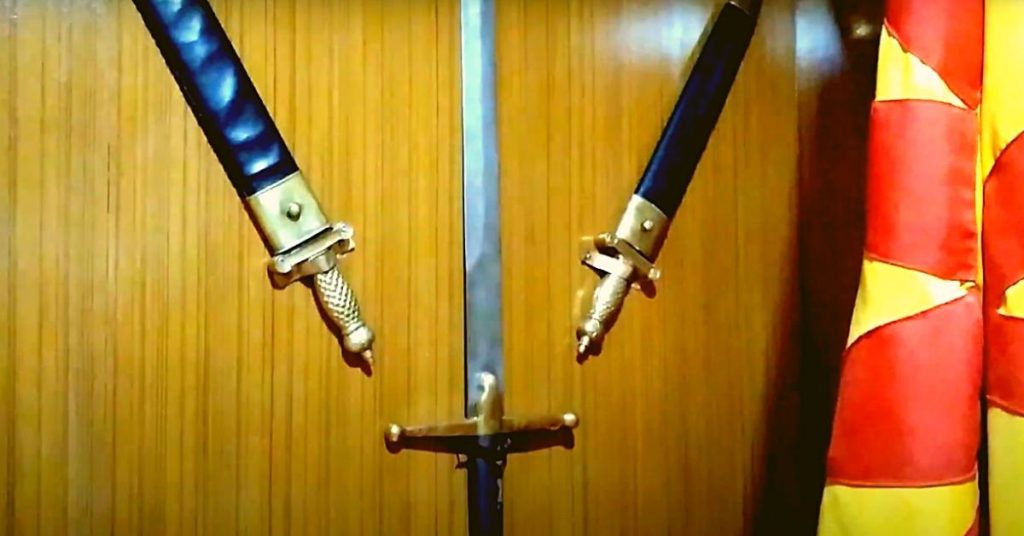

In the center, a gleaming bust of Gyalpo Tsepal Namgyal was kept. He was the king of Leh during Zorawar Singh’s first invasion. After facing a defeat, Namgyal agreed that Ladakh would become a vassal state under Maharaja Gulab Singh’s rule.
Behind the bust, a Mantalai Standard (the flag of the Chinese Imperial Army) was framed, which was similar to the one captured by Colonel Mehta Ram Basti from Tibetans in the Battle of Taklakote. Below the flag, a jewelry box, a lantern, and some head armors were displayed on the floor.


On the left wall, there was a picture of Colonel Mehta Ram Basti presenting the captured Tibetan flag to General Zorawar Singh after the Battle of Taklakote. On the right side was an image of the Samadhi (tomb) of Wazir Zorawar Singh constructed by the Tibetans. It was shaped like a chorten, and the Tibetan forces had buried the remains of General Zorawar Singh with full military honors. Numerous colorful flags fluttered over the chorten on a hill in Toyo, and the memorial is venerated even today.
History Room


We then moved on to the next section, the History Room. In this hall, we came across all sorts of historical information written on boards. The boards were split up into different parts for the reader’s convenience.
The First Ladakh Campaign 1834-36
One of them was a comprehensive description of The First Ladakh Campaign 1834-36. It described the defeat of Gyapo Tsepal Namgyal, the local ruler of Ladakh. The next board explained the Consolidation of Ladakh 1836-40.
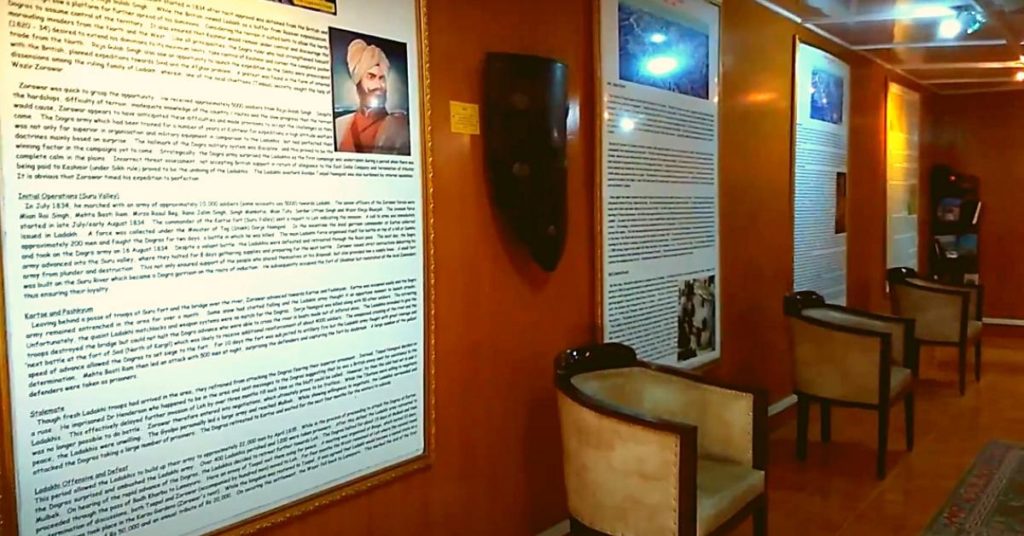

The Baltistan Campaign 1839-40
Moving on to the next one, which was about The Baltistan Campaign 1839-40. During those times, the Baltistan region was under the rule of Afghan chief Ahmad Shah Durrani. When General Zorawar Singh went to capture Baltistan, he lost many soldiers until Mehta Ram Basti rescued him. But once again, in the summer of 1840, Zorawar Singh gathered his army and then captured Baltistan.
In the center, there was a beautiful sculpture of Lord Buddha kept on a stand.
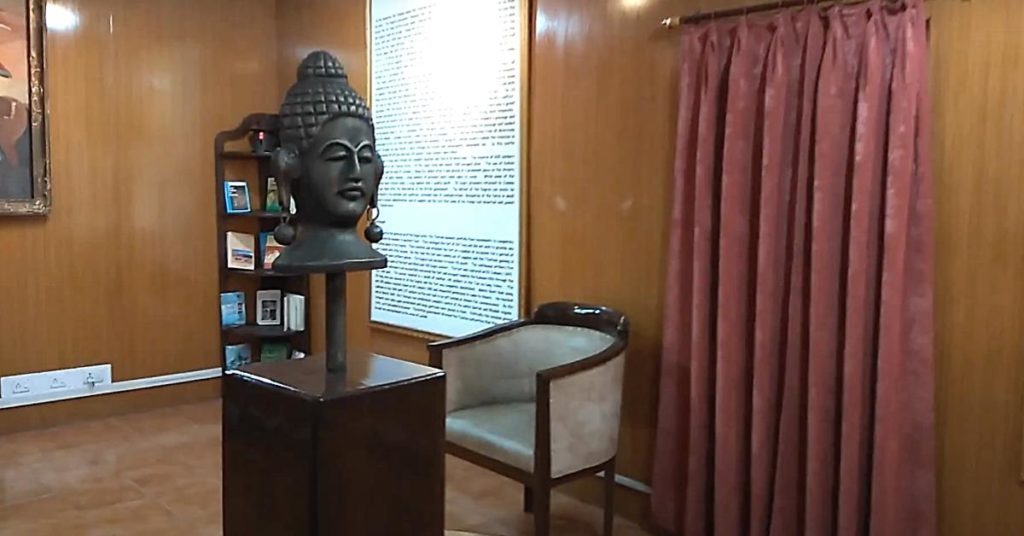

The Tibet Campaign 1841
On the other side, there was a board of the Tibet Campaign 1841. It gave a detailed description of the Tibet expedition. After the conquest of Ladakh and Baltistan, Zorawar Singh turned his army towards Tibet’s eastern regions. In May 1841, General Zorawar and his Hindu Dogra Rajput soldiers marched into Ladakh and eventually invaded Tibet.
The Great Reverse: Zorawar’s Last Struggle and the Tibetan Offensive
Heading on to the next ones, which was about The Great Reverse and Zorawar’s last struggle, the Tibetan offensive. One of the boards gave detailed information about Zorawar Singh’s military system. It discussed the military system, administration, organization, warfare techniques, and strategies adopted by Zorawar Singh that led to his spectacular success.


Reconquest of Ladakh 1842
Finally, the last board gave an account of the Reconquest of Ladakh in 1842. It recounted the significant events of the Chinese and Tibetian uprising, how the Dogras defeated them, and the rebels of Baltistan.
After that, we walked out of the museum towards the backyard, where canons and some war equipments were put on display.
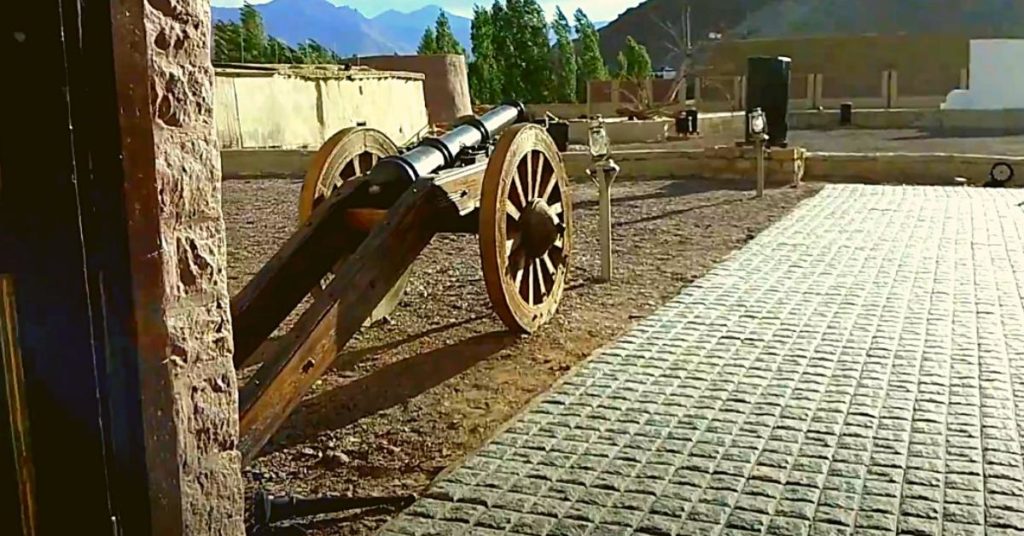

On the top, a giant Indian flag fluttered majestically, and from there, we saw the breathtakingly fascinating scenes of the mountains and the clear skies.
War Room (Yudh Kaksh)
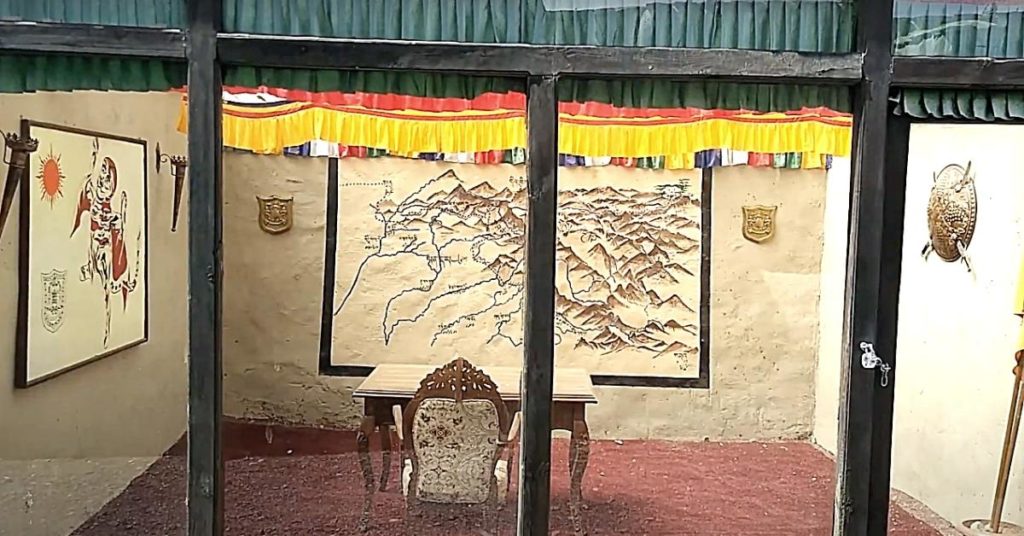

There was a War Room (Yudh Kaksh) where all the strategies and planning of the war were discussed. This room provided a secret headquarter for the Dogra Army Core group for planning further operations from Ladakh. The War Room accommodated military leaders of the Dogra and Ladakhi armies, such as General Zorawar Singh, Mehta Ram Basti, Dalel Singh, and the Ladakhi King Tsepal Gyapo Namgyal. A vast map, painting of tiger and different types of flags were also shown in this room.
On the other side, there was a mosque, a natural freshwater spring, and a temple dedicated to Goddess Kali and Durga.
After sightseeing, we had some tea and snacks in the cafeteria while enjoying the incredible views of the Stok Range and the Himalayas. In the evening, we enjoyed an exciting Sound and Light Show depicting Dogra’s history and the wars fought by General Zorawar Singh in Ladakh.
“Zorawar constructed a fort at Leh and left Dalel Singh in charge of the garrison“
Robert A. Huttenback
Best time to visit:
May to September is the best time to visit Zorawar fort, Leh. However, you must be aware that the Fort has not attracted tourists much during the winter seasons, so it remains shut from November to April.
How to reach Zorawar fort Leh?
One of the best ways to reach the Zorawar fort is during the Leh sightseeing. It would be best if you put the Zorawar fort in the Ladakh tour itinerary, and the driver will take you to the Zorawar fort.
Zorawar fort is in Leh on Skara road. It’s around 2 km away from Leh Market. If you stay in Skara or near Leh market, you can easily reach Zorawar fort within 10-20 minutes walking.
It takes about 5 minutes drive from Leh market to the Zorawar fort. Once there, you will be treated to the sightseeing of the Zorawar fort and the surroundings.
Hours of Operations and Entrance Fee
- Opening time: 10:00 am to 1:00 pm and 4:00 pm to 7:00 pm
- Entry Fee: INR. 20 per person
The Zorawar fort Hours of operation are in the mornings from 10:00 am to 1:00 pm and in the afternoons from 4:00 pm to 7:00 pm. As for the tickets, you can also book your ticket to Zorawar fort at the ticket counter near the entrance for INR. 20 per person.
Nearby Attractions:
Zorawar fort is in Leh, so you need to know about the nearby attractions to manage the whole day of your trip.
| Attraction | Distance | Travel Time |
| Main Bazaar Leh | 2.2 km | 5 min |
| Hall of Fame Leh | 3.6 km | 10 min |
| Leh Palace | 2.2 km | 5 min |
| Namgyal Tsemo | 5.8 km | 15 min |
| Central Asian Museum | 2.2 km | 5 min |
| Sankar Gompa | 3.6 km | 10 min |
| Shanti Stupa | 3.7 km | 10 min |
Navigate to Zorawar fort on Google Map.
Main Bazaar Leh
Main Bazaar Leh is 2 km away from the Zorawar fort Leh. After visiting the Zorawar fort, you can visit Leh bazaar to have your lunch.
Hall of Fame Leh
Hall of fame is 3.6 km away from the Hall of Fame Leh. It would take around 10 mins drive to arrive at the Hall of fame from Zorawar fort.
Leh Palace
It is around 2 km away from Zorawar fort. Have your lunch in Leh market and then you can visit Leh Palace.
Central Asian Museum
This place is also around 2 km away from Zorawar fort. The Central Asian Museum Leh is an exciting place to learn about the history and culture of Ladakh. It would take approximately five minutes to arrive there driving.
Sankar Gompa
Sankar Gompa is a monastery that is 3.6 km far from Zorawar fort Leh. It would take around 10 mins to reach there from Zorawar fort.
Shanti Stupa
Enjoy the panoramic view of the whole town from Shanti Stupa with the majestic mountains in the background. It is 3.7 km away from Zorawar fort Leh.
Namgyal Tsemo
Namgyal Tsemo is a monastery 5.8 km far from Zorawar fort Leh.
Insider tips for travelers
- Zorawar Fort is an important historical place that is well maintained by the Indian army, so preserve the decorum and sanctity of the Fort.
- Sunrays in Ladakh are of exceptionally high intensity. So, use sunscreen to protect your skin from harmful UV rays.
- Wear sunglass during sunny days
- Unlike other places of India, Weather in Ladakh keeps changing. So, keep checking the weather prediction report before visiting Zorawar fort.
- Prepaid SIM cards of other states won’t work in Ladakh. So, subscribe for a BSNL, Airtel, or Jio postpaid SIM card before visiting Ladakh.
- Please book your flight tickets early, as during the peak season the prices would go higher.
- Google flights have this fantastic feature of the flight price alert system. So, find your flight on google flights and then subscribe for the alert on Google flights.
- Bring some warm clothes and a jacket, from October to May.
- Rest for some time to acclimatize yourself on the first day of arrival.
